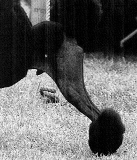


|
HINDQUARTERS |
|
|
|
Discussion Notes: |
|
||
|
1. Both the upper and lower thighs should be firm to the touch indicating correct muscle development (as illustrated in Figure A). |
 |
||
|
2.
To have correct angulation with correct action, it is
necessary that the tibia (Figure B, Point T) be longer than
the femur (Figure B, Point F) and that the hock joint
(Figure B, Point H) be well let down. Overangulation of the
hindquarters gives an unstable gait and generally indicates
an overlong loin; similarly, straight and/or weak
hindquarters (as illustrated in Figure C) do not provide the
required thrust; (also refer to GAIT/MOVEMENT). |
|
|
4. This precludes hocks which incline inwards (cow hocks) or outwards (bowed hocks). |